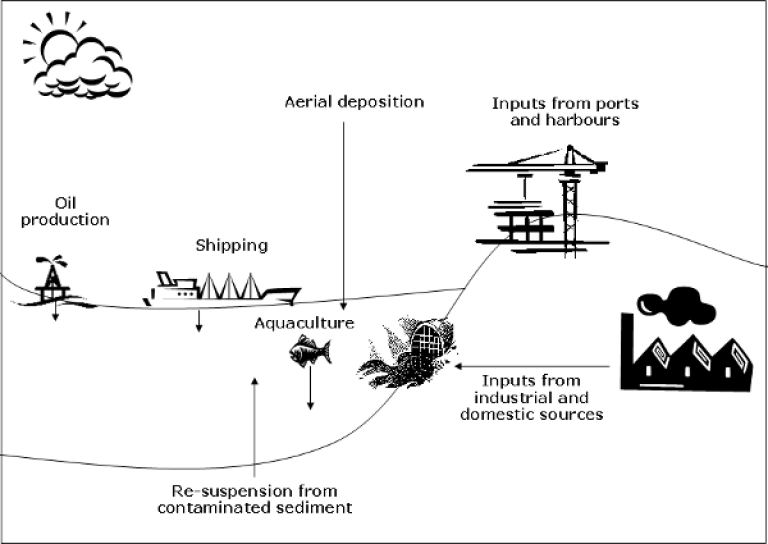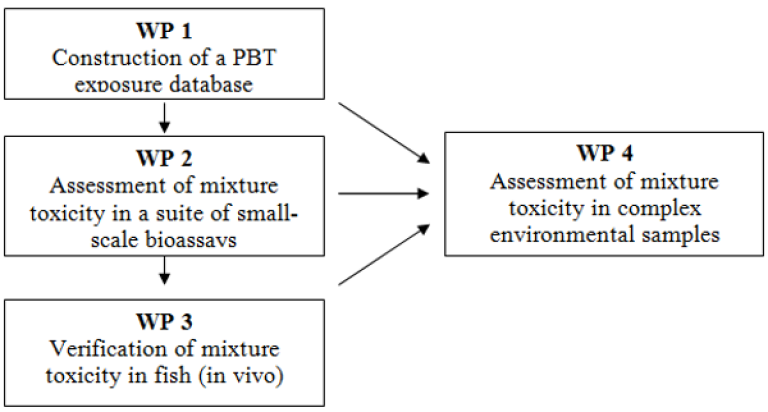MixTox
Assessment of mixture toxicity of compounds in discharges to the North Sea and coastal areas of Norway (MixTox).
About the project
Assessment of combinex toxicity of pollutants to the North Sea and Norwegian coastal areas through use of experimental and predictive modelling. NIVA addresses this challenge in the multi-national and multi-disciplinary research project MixTox funded by the Norwegian Research Council.
Background
The North Sea and coastal areas of Norway receive input of pollutants from various sources including discharges from land, maritime and offshore oil production activities, leakage from contaminated sediments and long-range atmospheric transport (fig. 1). These compounds exist as complex mixtures in the recipient and may consequently evoke effects through combination toxicity (mixture toxicity).
Due to lack of knowledge on the combined effects of marine pollutants and their mechanisms of effect, prediction of environmental impact and assessment of environmental risk are often assessed based on individual components and lack the ability to integrate combined toxicity, multiple mechanisms of effect and long-term effects due to more subtle mechanisms of toxic action. The lack of ability to address combined toxicity of chemicals in complex mixtures thus introduces a need for developing effect methods capable of addressing acute and chronic effects as well as implementation of prediction models that can be used to characterize the interaction occurring.

Project
The Norwegian Institute for Water Research (NIVA) managed a Norwegian Research Council (NRC) funded project “178621-Assessment of mixture toxicity of compounds in discharges to the North Sea and coastal areas of Norway (MixTox)” in the period 2007-2012.
Objectives
Determine the combined effects (mixture toxicity) of typical complex organic chemical mixtures originating from multiple exposure sources in Norwegian coastal areas and the North Sea. To evaluate whether the modelling approach is applicable to Norwegian exposure scenarios, assessment of the mixture toxicity of selected coastal discharges and contaminated harbour sediments will be performed.
Work packages
The proposed work will be divided into four work packages (WPs) where data and experiences will be shared between WPs (Fig 2.).

Figure 2. Overview of individual work packages (WP) and their internal relationship
WP 1: Construct a PBT exposure database that allow identification of compounds in emissions from North sea and coastal emissions of high concern
WP 2: Assessing combined toxicity of compounds identified in WP1 in a battery of small-scale/in vitro bioassays using state-of-the-art prediction models
WP3: verify combined toxicity in fish embryos as a model system for small fish species
WP4: using a combination of effect-directed analysis (EDA) and combined toxicity prediction modelling to address mixture toxicity under relevant exposure scenarios.
Project results
Multiple stressors and short term effects on Atlantic salmon (Salmo salar)
The individual and combined molecular acute stress responses of depleted uranium and ionizing radiation was tested in a series of short-term studies with juvenile salmon (Salmon salar) by use of microarrays and quantitative rtPCR. The results showed that depleted uranium and gamma radiation resulted in unique molecular changes which could be characterized by gene expression profiles. The combined effect of these stressors appeared to be quite different from the contribution from each single stressor. In some cases, depleted uranium affected the response of ionizing radiation whereas in other cases the ionizing radiation affected the response of depleted uranium. In a few cases responses that could not be ascribed to the effect of the single stressors was observed, which suggest that potentiation of single responses by exposure to other stressors were observed. The work was a collaboration between the MixTox project and a PhD project on multiple stressors (PhD student You Song) at the department of Plant and Environmental Sciences, University of Life Sciences (UMB).
Combined effects of cytotoxic compounds on primary hepatocytes
The combined effects of up to 6 naphthenic acids were tested in a primary culture of rainbow trout hepatocytes using metabolic activity and membrane integrity as markers for cytotoxic effects. The additivity expectations were calculated by the concentration addition (CA) and independent action (IA) prediction models. The naphthenic acids acted in an additive manner at the whole concentration range tested and the observed effects were closer to the CA than the IA model. The work has been published in Environmental Science and Technology.
Combined effects of estrogenic compounds on transgenic zebrafish embryos
The combined effects of estrogenic chemicals were tested in transgenic (cyp19a1b-GFP) zebrafish embryo and primary cultures of rainbow trout hepatocytes to determine if the transgenic zebrafish embryo assay is suitable for screening of combined effects of estrogenic compounds. The effects of the estrogenic mixtures on the zebrafish embryos were mainly additive and were well estimated by both the concentration addition (CA) and independent action (IA) prediction models. Lower than additive effects were only observed for one mixture and only at the highest tested mixture concentrations. One of the mixtures was also tested in a primary hepatocyte culture, using the in vitro production of vitellogenin as biomarker for estrogenic effects. The effect of the non-toxic concentrations was well predicted by CA and IA in both assays. Overall, a similar response was observed in the two models despite different cellular contexts, and it appears that transgenic zebrafish embryos and rainbow trout hepatocytes are suitable model systems for studying the combined effects of estrogenic compounds. The work has been published in Aquatic toxicology.
Combined effects of organic contaminants on Skeletonema costatum
The combined effect of relevant environmental contaminants emitted to coastal waters (pharmaceuticals and personal care products (PPCPs), biocides, polyaromatic hydrocarbon (PAH) and alkylphenol) was tested on the growth of the marine algae S. costatum. Six binary mixtures were tested and were all found to have additive effects on the growth of S. costatum as the observed results were well estimated by CA and IA. The observed effects of a mixture of eight compounds containing PPCPs, biocides, PAH and alkylphenol were positioned between the additivity expectations for CA and IA, and indicate that the combined effects of PPCPs and other relevant pollutants act additive on S. costatum. PPCPs will contribute to the chemical load and increase the risk of biologic effects in areas contaminated with other organic pollutants like antifoulants, PAHs and alkylphenols. .
Combined effects of estrogen agonists in a primary culture of rainbow trout hepatocytes
The combined effect of up to 7 estrogen receptor (ER) agonists were tested in a primary culture of rainbow trout hetpatocytes using induction of ER-mediated production of vitellogenin (Vtg) as a biomarker for estrogenicity. The ER agonists acted in an additive manner at low and intermediate total mixture concentrations and less than additive at high total mixture concentrations in primary cultures of rainbow trout hepatocytes. The prediction models CA and IA provided good estimates for the combined effect of the mixtures at low to intermediate total mixture concentrations. The work has been published in Aquatic Toxicology.
Combined effects of oestrogen receptor antagonists on in vitro vitellogenesis
The combined effect of up to 11 estrogen receptor (ER) antagonists were tested in a primary culture of rainbow trout hetpatocytes using reduction of ER-mediated production of vitellogenin (Vtg) as a biomarker for antiestrogenicity. Estrogen receptor antagonists with similar mode of action were found to act additive and the effect could be estimated by the prediction models CA and/or IA. Mixtures of ER antagonists with different and/or unidentified modes of action had stronger reduction potential on the Vtg production than predicted by CA and IA. The work has been published in Aquatic Toxicology.
More information: Contact You Song, PhD
Project partners
MixTox was a multi-disciplinary initiative.
- Harald Hasle Heiaas, Kevin Thomas, Kathrine Langford, Karina Petersen and Knut Erik Tollefsen, Norwegian Institute for Water Research (NIVA)
- Gunnar Brunborg, Norwegian Institute of Public health (FHI)
- Rolf Altenburger, Stefan Scholz and Eva Fetter, Helmholtz Zentrum für Umweltforschung (UFZ)
- Ketil Hylland, University of Oslo (UiO)
- You Song, Brit Salbu, Bjørn Olav Rosseland, Norwegian University of Life Sciences (UMB)
 Knut Erik Tollefsen
Knut Erik Tollefsen